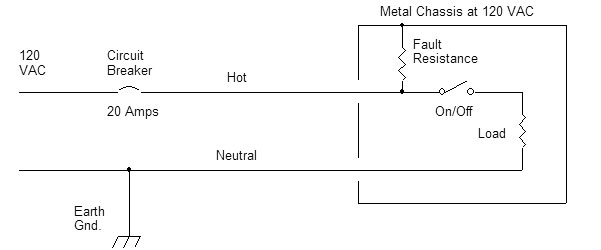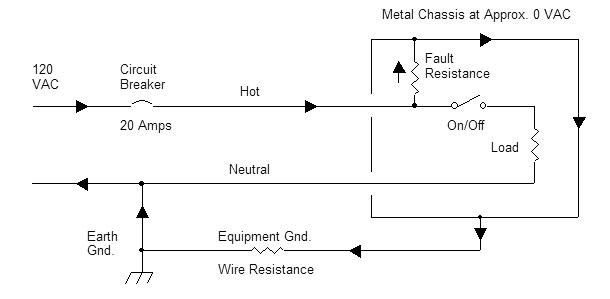The National Electrical Code (NEC) requires that all exposed metal on equipment and appliances be connected to an equipment grounding conductor. Under normal circumstances, no current flows in the equipment grounding conductor. The following example illustrates the purpose of the equipment grounding conductor.
Figure 1 is the schematic of an appliance without an equipment grounding conductor connected to the metal chassis. The appliance is sitting on a wood table, and therefore isolated from earth ground. The appliance is "OFF", but a wire insulation fault has occurred before the switch. The metal chassis of the appliance is at an electrical potential of 120 volts with respect to earth ground. Since the switch is "OFF" and there is no path for fault current to flow, no current flows in this circuit. Hence, the circuit breaker will not trip, and the fault will go undetected.

Figure 1. Appliance with a Wire Insulation Fault.
Now assume that someone is in contact with earth ground, and they touch the metal chassis. There is now a path for fault current to flow, and it is through them! This is depicted in Figure 2.

For the circuit breaker to trip, the sum of the three resistances in the fault path must be less than 6 ohms. The internal resistance of the human body from any limb to any limb is approximately 500 ohms. In addition, the earth resistance may or may not be less than 6 ohms. The only requirement in the National Electric Code (NEC) is that the resistance of the grounding electrode (ground-rod) be less than 25 ohms. Hence, even if the appliance is not isolated from earth ground, the ground resistance may limit the fault current to below the trip point of the circuit breaker. Furthermore, there is usually considerable resistance between the appliance and earth ground. For example, the appliance may be sitting on a concrete slab.

Figure 3 depicts the same appliance with an equipment grounding conductor connected to the metal chassis. The equipment grounding conductor provides a low resistance path for the fault current. If the equipment grounding conductor is 100 feet of copper wire, size AWG #12, then it has a resistance of less than 0.2 ohms. If the fault resistance is less than 5.8 ohms, then more than 20 amperes of fault current will flow in this circuit, and the circuit breaker will trip and deenergize the circuit. If the fault resistance is more than 5.8 ohms, the circuit breaker will not trip. However, the equipment grounding conductor will still hold the metal chassis to a safe voltage. More precisely, since the maximum fault current without the circuit breaker tripping is 20 amperes, the maximum voltage at the metal chassis with respect to ground is 20 * 0.2, which is 4 volts.
Case History
Electrocution at Deer Creek School
Links:
References: